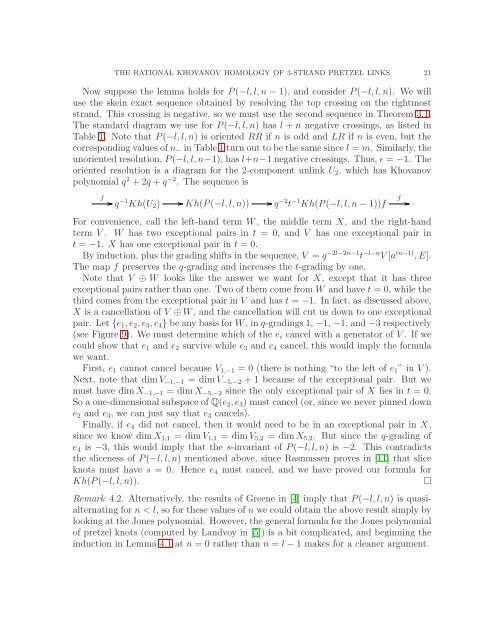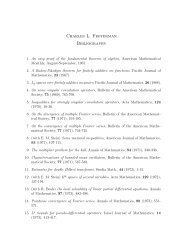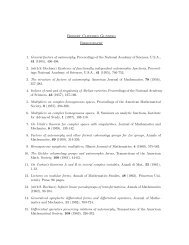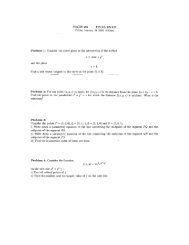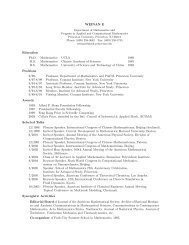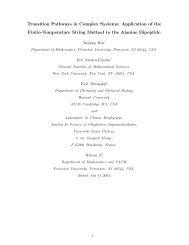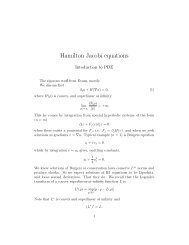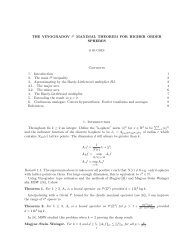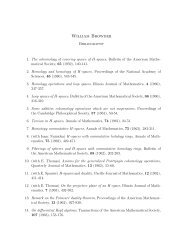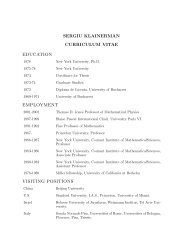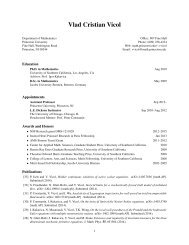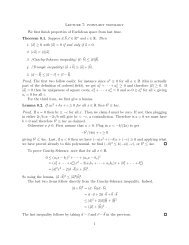The rational Khovanov homology of 3-strand pretzel links
The rational Khovanov homology of 3-strand pretzel links
The rational Khovanov homology of 3-strand pretzel links
Create successful ePaper yourself
Turn your PDF publications into a flip-book with our unique Google optimized e-Paper software.
THE RATIONAL KHOVANOV HOMOLOGY OF 3-STRAND PRETZEL LINKS 21<br />
Now suppose the lemma holds for P(−l,l,n − 1), and consider P(−l,l,n). We will<br />
use the skein exact sequence obtained by resolving the top crossing on the rightmost<br />
<strong>strand</strong>. This crossing is negative, so we must use the second sequence in <strong>The</strong>orem 3.1.<br />
<strong>The</strong> standard diagram we use for P(−l,l,n) has l + n negative crossings, as listed in<br />
Table 1. Note that P(−l,l,n) is oriented RR if n is odd and LR if n is even, but the<br />
corresponding values <strong>of</strong> n − in Table 1 turn out to be the same since l = m. Similarly, the<br />
unoriented resolution, P(−l,l,n−1), has l+n−1 negative crossings. Thus, ǫ = −1. <strong>The</strong><br />
oriented resolution is a diagram for the 2-component unlink U 2 , which has <strong>Khovanov</strong><br />
polynomial q 2 + 2q + q −2 . <strong>The</strong> sequence is<br />
f<br />
q −1 Kh(U 2 ) Kh(P(−l,l,n)) q −2 t −1 Kh(P(−l,l,n − 1))f<br />
For convenience, call the left-hand term W, the middle term X, and the right-hand<br />
term V . W has two exceptional pairs in t = 0, and V has one exceptional pair in<br />
t = −1. X has one exceptional pair in t = 0.<br />
By induction, plus the grading shifts in the sequence, V = q −2l−2n−1 t −l−n V [a (n−1) ,E].<br />
<strong>The</strong> map f preserves the q-grading and increases the t-grading by one.<br />
Note that V ⊕ W looks like the answer we want for X, except that it has three<br />
exceptional pairs rather than one. Two <strong>of</strong> them come from W and have t = 0, while the<br />
third comes from the exceptional pair in V and has t = −1. In fact, as discussed above,<br />
X is a cancellation <strong>of</strong> V ⊕ W, and the cancellation will cut us down to one exceptional<br />
pair. Let {e 1 ,e 2 ,e 3 ,e 4 } be any basis for W, in q-gradings 1, −1, −1, and −3 respectively<br />
(see Figure 9). We must determine which <strong>of</strong> the e i cancel with a generator <strong>of</strong> V . If we<br />
could show that e 1 and e 2 survive while e 3 and e 4 cancel, this would imply the formula<br />
we want.<br />
First, e 1 cannot cancel because V 1,−1 = 0 (there is nothing “to the left <strong>of</strong> e 1 ” in V ).<br />
Next, note that dimV −1,−1 = dim V −5,−2 + 1 because <strong>of</strong> the exceptional pair. But we<br />
must have dimX −1,−1 = dim X −5,−2 since the only exceptional pair <strong>of</strong> X lies in t = 0.<br />
So a one-dimensional subspace <strong>of</strong> Q(e 2 ,e 3 ) must cancel (or, since we never pinned down<br />
e 2 and e 3 , we can just say that e 3 cancels).<br />
Finally, if e 4 did not cancel, then it would need to be in an exceptional pair in X,<br />
since we know dim X 1,1 = dimV 1,1 = dimV 5,2 = dimX 5,2 . But since the q-grading <strong>of</strong><br />
e 4 is −3, this would imply that the s-invariant <strong>of</strong> P(−l,l,n) is −2. This contradicts<br />
the sliceness <strong>of</strong> P(−l,l,n) mentioned above, since Rasmussen proves in [11] that slice<br />
knots must have s = 0. Hence e 4 must cancel, and we have proved our formula for<br />
Kh(P(−l,l,n)).<br />
□<br />
Remark 4.2. Alternatively, the results <strong>of</strong> Greene in [4] imply that P(−l,l,n) is quasialternating<br />
for n < l, so for these values <strong>of</strong> n we could obtain the above result simply by<br />
looking at the Jones polynomial. However, the general formula for the Jones polynomial<br />
<strong>of</strong> <strong>pretzel</strong> knots (computed by Landvoy in [5]) is a bit complicated, and beginning the<br />
induction in Lemma 4.1 at n = 0 rather than n = l − 1 makes for a cleaner argument.<br />
f<br />
.


